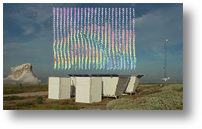 Speed color-coded wind barb profiles measured with the NOAA/ETL integrated wind profiler observing system. |
Coastal Processes Team
Dr. Allen White, Team Lead
Impacts of Weather on Coastal Regions
Coastal areas of the U.S. contain most of our nation's population and economic power and yet are exceptionally vulnerable to the adverse impacts of weather. Because of this need, and the great potential of research and forecast applications development to reduce these adverse impacts through innovative use of new technology, NOAA/ETL formed the Coastal Weather and Air Quality Program. It is built upon the leadership role the group has played in both summer and winter season west-coast weather and air quality research, and in coastal forecast applications development. Research expertise includes boundary layer physics, coastal dynamics, mountain effects, polar science, and technology assessment. These talents are combined with extensive field experience and close collaborations with NWS, to assess operational impacts of new data and physical understanding.
This program creates a unique capability within NOAA in terms of coastal and air quality issues to assess new technology by understanding what needs to be measured, how to measure it, and how to extract the most useful information. A key example of the program's capabilities are found in the CALJET/PACJET experiments, which were developed and led by the group and have brought researchers and operational weather forecasters together to identify and solve major forecast problems on the U.S. west coast. Also, in a 15-year long series of air quality studies in the Western and Southeastern U.S. the group has led core components of the experiments focused on the role that meteorology plays in the formation and distribution of ozone and fine particles in the lower troposphere.
